Gallery
What is Woodland Art
Woodland Art, also known as Legend Painting or Medicine Painting, is a distinct style of native artthat blends traditional legends and myths with contemporary mediums. It explores the relationships between people, animals and plants and is rich with spiritual imagery and symbolism.
CHRISTIAN MORRISSEAU ART AUCTION FRIDAY MARCH 1OTH
LIVE & ONLINE FIND OUT MORE HERE

Woodland Art Symbolism
The Meaning of the Woodland Art Symbolism
Woodland Art, also known as Legend Painting or Medicine Painting, is a distinct style of native artthat blends traditional legends and myths with contemporary mediums. It explores the relationships between people, animals and plants and is rich with spiritual imagery and symbolism.
With its bright colours, bold lines and 2-dimensional design, Woodland Art is one of the most recognizable forms of native art. The visionary style emphasizes heavy black formlines and x-ray views of colourful, figurative images. The perspective is strictly frontal, profile or aerial, lacking ground lines and indications of horizons. But don’t be deceived by its visual simplicity—the subjects and themes explored in Woodland paintings carry powerful meanings.
Native symbolism is at the heart of Woodland Art, yet the mediums are anything but traditional. Woodland paintings are typically acrylic or watercolour paints on paper, canvas or wood panels.
Norval Morrisseau is considered to be the founder of the Woodland School of Art. He was the first Ojibwa to break the tribal rules of setting down native legends in picture form, and was originally criticized for disclosing traditional spiritual knowledge. However, his unique style gained traction in the late 1960s, revitalizing traditional Ahnisnabae icons and inspiring generations of artists to follow.
Today Christian Morrisseau carries on his father’s legacy incorporating many of the same symbols into his imagery.
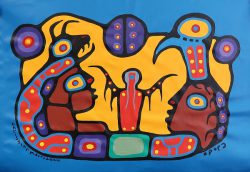
Lines of Communication
Woodland artists often portray animals and people joined with flowing lines which indicate relationships which reflect the artist’s understanding of the nature of the interdependence between the two beings.
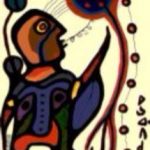
Lines of Prophecy
Some powerful creatures may have narrow ivy-like lines spewing from their mouths which indicate more than simple speech – they indicate prophecy, particularly in association with shaman imagery.
A good example is this painting by Norval Morrisseau showing a shaman making direct communication with the universal life force.
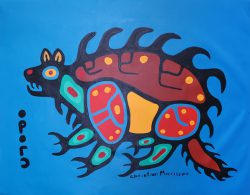
Lines of Movement
Very short lines, clustered near an organ like a heart as in this example, indicate movement and an active attempt at communication with the viewer. The lines are particularly significant surrounding shaking tent imagery.
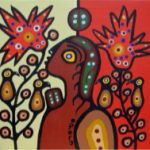
The Divided Circle
A circle divided in half, connected with the main image by lines of communication is an especially meaningful symbol used by woodland artists. The divided circle represents dualities present in the world – good and evil, day and night, sky and earth, honest and dishonest, function and dysfunction for example.

X-Ray Decoration
The term would have been meaningless to prehistoric woodland artists, but nowadays the concept of an x-ray view aptly describes the way woodland artists depict inner structures of people and animals. They are representations of inner spiritual life.

Color
In prehistoric times the only significant colour used was red ochre as in this ancient image of mishpashu (a water spirit) on a cliff overlooking Lake Superior. In 1937 the image had been covered over with dark green oil based house paint by the twelve year old daughter of the local Indian agent. More than seventy years later the green paint has been destroyed by the elements but the original ochre illustration still stands proud.
Christian Morrisseau uses a much broader palette, like his father. In addition his work has characteristics of stained glass – black lines of power provide outlines which are filled with brilliant colours.
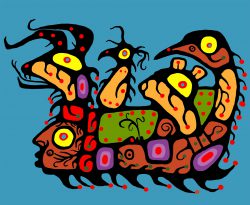
Symbolism of Color
White – Spirituality
Red – Life
Blue – inspiration and divine wisdom, confidence, integrity, self-reliance.
Light Blue – spiritual protection
Yellow – soul development
Blight Yellow – courage and hope
Pale Yellow – higher development
Orange – vitality
Green – individualism and regeneration
Grey – convention and formality
Brown – organization and orderliness
Violet – power of subconscious mind
Black – power and outlines
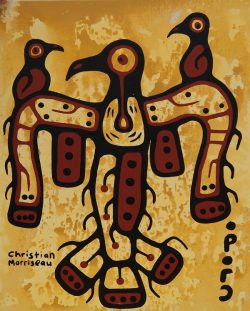
The Thunderbird
The thunderbird is the messenger between the spirit and human worlds. Through these paintings Christian is able to reveal the mythology of his people to the viewers of his work.
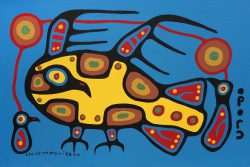
Spiritual Beings
The Ojibway consider all living things – animals, birds, fish and plants – as spiritual beings. Christian often depicts them in his paintings as having superhuman powers.